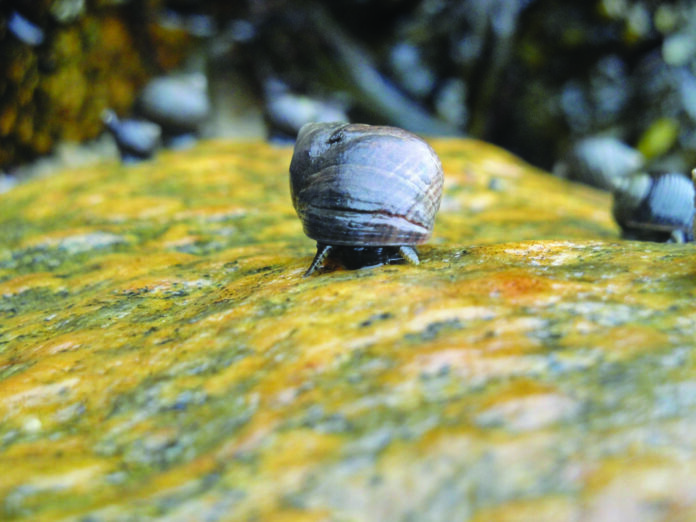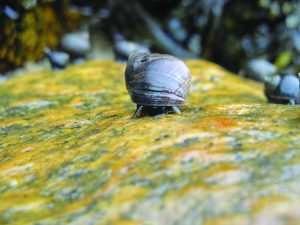
BY HARRY WEEKES

My in-laws live on Long Island Sound amidst orangey-pink lumps of granite. Over hundreds of thousands of years, the ocean has pulsed, up and down, in and out, night and day, at the fringes of these rocks. Currently, I am clinging to one of them, partially upside down, feeling the blood throb in my head.
I am staring at snails. I think they are common periwinkles. There is a herd grazing on a ledge above a gradually receding tide. While snails are the poster-children of slow movement, there is something mesmerizing about how they move. They glide. At the base of the shell of the algal herbivore I am watching, two eye stalks poke out, as the small beast swivels and floats like a puck on ice (I am here displaying the limits of my experience with things, and the limiting of things to my experience—I am sure there is a much more elegant and apt analogy, but it was either this, an air hockey disc, or a curling stone).
I am wondering, “Does this snail have any sense that I exist?”
As if to emphasize the question, I reach down and grab the shell as gently as I can. Immediately, the snail releases the rock and closes its operculum—a thin, hard plate designed to seal the snail in, and protect against everything from prying predators to drying out during daily tide shifts.
On one hand, this snail’s response lets me know that it knows I exist. It doesn’t take long, though, before the operculum opens up and the snail reaches out, twisting, searching for a surface on which to graze and glide. It would seem, then, that a patient and gentle giant is not quite in its worldview.
Unless, of course, this is what you do with giants—just go about your business, as they will eventually return you to where you were.
These days, it is hard not to stand at the edge of the ocean and think about sea level rise. In the mountains of Idaho, even a one hundred-foot rise in the oceans is an abstraction. On the shore, I know exactly what a two- to six-foot rise looks like—it happens every day, roughly twice a day; it’s called the tide.
And there seems to be a potential problem here—people who don’t live on the ocean have no direct connection to sea level rise, and those who do, know that the sea rises and falls all of the time, always masking and constantly adjusting any sense of what is normal, and simultaneously dampening any sense that this rise is either urgent or alarming.
Such musings are, of course, at our scale. From the scale of periwinkles, things are a bit different. On one hand, theirs is a world of much more significant extremes, moving from complete inundation, which is always coupled with jarring wave activity, to total desiccation. They control this world by gently gliding up and down the slopes of the intertidal zone, daily pulsing in and out, not unlike the annual ebb and flow of sheep into and out of our mountains. The calibration of snails is necessarily constant.
On the other hand, this daily pulsing must lead to a certain kind of long-term ambivalence (if snails feel such things). From where I am dangling, it doesn’t take much to look upslope and think of all of the places and perches these snails would happily colonize. Ultimately, theirs is a world that follows the edge of the sea, wherever that sea edge may be.
This leads to another, more humbling thought, a subtle adjustment to my original question: “Will these snails even know that I existed?”
Harry Weekes is the founder and head of school at The Sage School in Hailey. This is his 47th year in the Wood River Valley, where he lives with his wife Hilary and their three kids—Georgia, Penelope and Simon—a nice little flock.
